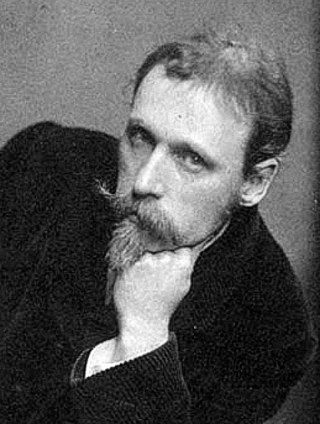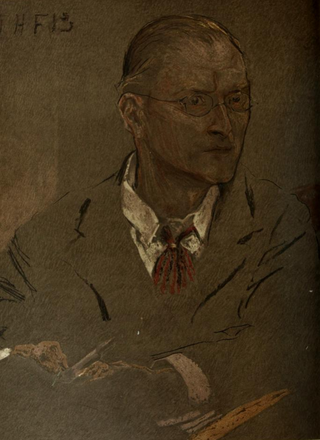Career
In the 1950s, after she was married and had children, Armitage started designing and making lino-cut wallpaper. [3] Over time, she became known for her hand-drawn and hand-printed designs. [4]
After sketching the design, she uses hand-cut lino blocks and a century-old offset lithographic printing press to create custom-printed rolls of wallpaper. [5] [6] She works in a studio in her garage, where she keeps her printing press. Her daughter, Joanna Broadhurst, works as her assistant. [7]
In 1993 she was elected as Master of the Art Workers' Guild. [8]
In 2004, the historic wallpaper design company Hamilton Weston agreed to represent her work. Sigmar London also sell her work. [9] She designed a wallpaper she entitled "Alphabet" for The Woman in Black, which was created for the film which is based on Susan Hill’s ghost story. Armitage's designs cover the nursery, which is haunted, with automata. The nursery is featured in the scenes where Daniel Radcliffe's character faces off with the titular character. [10]
As of 2020, Armitage was also producing wallpapers through digital processes. [11] In 2018 she was commissioned to create digitally printed wallpaper on vinyl, for the West Middlesex University Hospital in Isleworth, West London. [12]

Lithography is a planographic method of printing originally based on the immiscibility of oil and water. The printing is from a stone or a metal plate with a smooth surface. It was invented in 1796 by the German author and actor Alois Senefelder and was initially used mostly for musical scores and maps. Lithography can be used to print text or images onto paper or other suitable material. A lithograph is something printed by lithography, but this term is only used for fine art prints and some other, mostly older, types of printed matter, not for those made by modern commercial lithography.
Needlepoint is a type of canvas work, a form of embroidery in which yarn is stitched through a stiff open weave canvas. Traditionally needlepoint designs completely cover the canvas. Although needlepoint may be worked in a variety of stitches, many needlepoint designs use only a simple tent stitch and rely upon color changes in the yarn to construct the pattern. Needlepoint is the oldest form of canvas work.

An illustration is a decoration, interpretation, or visual explanation of a text, concept, or process, designed for integration in print and digitally published media, such as posters, flyers, magazines, books, teaching materials, animations, video games and films. An illustration is typically created by an illustrator. Digital illustrations are often used to make websites and apps more user-friendly, such as the use of emojis to accompany digital type. Illustration also means providing an example; either in writing or in picture form.

Wallpaper is used in interior decoration to cover the interior walls of domestic and public buildings. It is usually sold in rolls and is applied onto a wall using wallpaper paste. Wallpapers can come plain as "lining paper" to help cover uneven surfaces and minor wall defects, "textured", plain with a regular repeating pattern design, or with a single non-repeating large design carried over a set of sheets.

Walter Crane was an English artist and book illustrator. He is considered to be the most influential, and among the most prolific, children's book creators of his generation and, along with Randolph Caldecott and Kate Greenaway, one of the strongest contributors to the child's nursery motif that the genre of English children's illustrated literature would exhibit in its developmental stages in the later 19th century.

Elizabeth Corbet Yeats, known as Lolly, was an Irish educator and publisher. She worked as an art teacher and published several books on art, and was a founder of Dun Emer Press which published several works by her brother W. B. Yeats. She was the first commercial printer in Ireland to work exclusively with hand presses.

Morris, Marshall, Faulkner & Co. (1861–1875) was a furnishings and decorative arts manufacturer and retailer founded by the artist and designer William Morris with friends from the Pre-Raphaelites. With its successor Morris & Co. (1875–1940) the firm's medieval-inspired aesthetic and respect for hand-craftsmanship and traditional textile arts had a profound influence on the decoration of churches and houses into the early 20th century.

Charles Francis Annesley Voysey was an English architect and furniture and textile designer. Voysey's early work was as a designer of wallpapers, fabrics and furnishings in a Arts and Crafts style and he made important contribution to the Modern Style, and was recognized by the seminal The Studio magazine. He is renowned as the architect of several country houses.

Textile design, also known as textile geometry, is the creative and technical process by which thread or yarn fibers are interlaced to form a piece of cloth or fabric, which is subsequently printed upon or otherwise adorned. Textile design is further broken down into three major disciplines: printed textile design, woven textile design, and mixed media textile design. Each uses different methods to produce a fabric for variable uses and markets. Textile design as an industry is involved in other disciplines such as fashion, interior design, and fine arts.

Florence Maud Broadhurst was an Australian painter, wallpaper and fabrics designer and vaudevillian singer, dancer and musician as well as a businesswoman, charity worker and teacher.

Désirée Lucienne Lisbeth Dulcie Day OBE RDI FCSD was one of the most influential British textile designers of the 1950s and 1960s. Day drew on inspiration from other arts to develop a new style of abstract pattern-making in post-war British textiles, known as 'Contemporary' design. She was also active in other fields, such as wallpapers, ceramics and carpets.

Edmund Evans was an English wood-engraver and colour printer during the Victorian era. He specialized in full-colour printing, a technique which, in part because of his work, became popular in the mid-19th century. He employed and collaborated with illustrators such as Walter Crane, Randolph Caldecott, Kate Greenaway and Richard Doyle to produce what are now considered to be classic children's books. Little is known about his life, although he wrote a short autobiography before his death in 1905 in which he described his life as a printer in Victorian London.
Margaret MacGregor Angus was a British painter, designer and teacher. Born in Chile, she spent her career in Britain.
Patricia Denise Guild OBE is a British designer and the founder and Creative Director of Designers Guild an international home and lifestyle company. She is known for her fabric and wallpaper collections and her work as a designer and manufacturer on a range of home interior products. She was awarded an OBE for services to interior design in 2008.
Jo Ratcliffe is a London based artist known for her kaleidoscopic animations, strange hand-drawn characters, and spindly scenes sometimes overlain atop live action footage. She is frequently commissioned by fashion labels and magazines to create art films, animations and editorials that appear both online and in print. Her illustrations are highly visible, regularly featured on the covers of Vogue Nippon and Vogue UK, as well as in the promotional imagery of Louis Vuitton. Ratcliffe is also an animation director and designer for notable clients such as Lady Gaga, Kenzo, Barneys New York, Jimmy Choo and Louis Vuitton. Her in-house studio consists of herself and a specialist team focusing on illustration, animation, graphic design, logo design, and other various disciplines.

Marion Victoria Dorn also known as Marion Dorn Kauffer was a textile designer primarily in the form of wall hangings, carpeting and rugs, however she is also known to have produced wallpaper, graphics, and illustrations. Known for her significant contributions to modern British interiors in particular for her 'sculpted' carpets, she contributed to some of the best-known interiors of the time including the Savoy Hotel, Claridges, the Orion and the Queen Mary. In the late 1930s and early 1940s she created moquette fabric designs for use in London Transport passenger vehicles.
Johanna Basford is a Scottish illustrator. Her illustrations are hand-drawn, predominantly in black and white, with pencils and pens. Basford's works can be found in products such as colouring books, wallpaper, beer labels and even tattoos. She is known to be a pioneer of the adult colouring book trend.

Ilonka Karasz, was a Hungarian-American designer, interior decorator, painter and illustrator known for avant-garde industrial design and for her many New Yorker magazine covers.

The British literary figure and designer William Morris (1834-1896), a founder of the British Arts and Crafts Movement, was especially known for his wallpaper designs. These were created for the firm he founded with his partners in 1861, Morris, Marshall, Faulkner and Company, and later for Morris and Company. He created fifty different block-printed wallpapers, all with intricate, stylised patterns based on nature, particularly upon the native flowers and plants of Britain. His wallpapers and textile designs had a major effect on British interior designs, and then upon the subsequent Art Nouveau movement in Europe and the United States.

William Morris (1834-1898), a founder of the British Arts and Crafts movement, sought to restore the prestige and methods of hand-made crafts, including textiles, in opposition to the 19th century tendency toward factory-produced textiles. With this goal in mind, he created his own workshop and designed dozens of patterns for hand-produced woven and printed cloth, upholstery, and other textiles.













